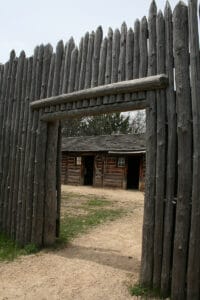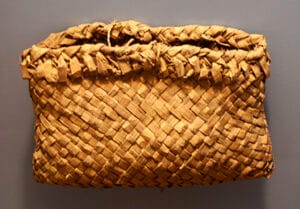With snow flurries teasing us, and Christmas carols playing, and wreaths and decorations everywhere, I wonder about the voyageurs during this season. Mostly, they celebrated New Year’s with a dram or two, occasionally with a rival post (as I wrote about in a post Celebrate Christmas like the voyageurs?). It doesn’t match with our ways.
Still, ’tis the season to think about gifts and gratitude. This was true for voyageurs too, though not like our lists for shopping now. But giving and gratitude was an important first step in the fur trade process.

Before they could begin the process of trading, voyageurs had to build a post where Native Americans could trade their foods and furs.
By early October the voyageurs had arrived at their wintering posts with loads of new goods from the rendezvous, ready to start trading. But if they were opening a new post, the engages (the heavy lifters) would first have to speed-build —
1. storage for the trade goods,
2. a trading counter, quarters for the head trader,
3. bunks for themselves,
4. storage for furs brought in by Natives
— all before the flag rose to signal the opening of trade.
The Ojibwe were eager to see the French-Canadian traders (some of whom were married to their daughters or sisters). They could replace broken tools or worn-out blankets or get things they’d hoped for — not so different from our lists and hopes. And they were curious about what news the traders brought, because this new USA was clearly moving in lots of people — and settling on their lands.
Before the actual trading process began, two critical rituals were observed — gift-giving and arranging for food.
Gifts greased the wheels
Sharing was a long-established Native American tradition — gift-giving inspired trust and strengthened relationships. For their gifts, the First Americans often brought things they (or their wives) had crafted, like moose hide moccasins.
According to Bruce White’s article “A Skilled Game of Exchange: Ojibway Fur Trade Protocol,” the French-Canadians understood that by creating long-term goodwill they were making a financial investment in the Native communities. They reciprocated with beads and metal tools, like needles or fish hooks, as well as tobacco and alcohol.
Alexander Henry, the Younger gave exactly the same gifts to each, regardless of whether a man was a great hunter or important chief.
- Men received 1 scalper, 2 folders, 4 flints.
Women were given 2 awls, 3 needles one skein net thread, 1 fine steel, a little vermilion and half a fathom of tobacco.
John Tanner, a white captive who came of age with the Ojibwe in the Red River area in 1800, said that his
adopted mother gifted the trader with 10 fine beaver skins. “In return for this accustomed present, she was in the habit of receiving every year a chief’s dress and ornaments, and a ten-gallon keg of spirits.” (told in “The Youngest Voyageur”)
In “History of the Ojibway People,” William Warren wrote that in the 1780s, alcohol was only given during the initial fall trading ceremony — a great indulgence once a year. However, tribesmen came to view alcohol as the ultimate kind of food. Alcohol also was given to celebrate the end of the trading season. In later years that unfortunately became copious amounts of alcohol. [This should be a future blog post.]
Arranging for food

Cedar pouch for wild rice (image courtesy of Wikimedia Commons)
Then came food discussions. To survive the winders, traders depended on the Native Americans to provide foodstuffs — hunting and fishing territories were well-defined for the tribes but voyageurs didn’t have those rights. And often they didn’t have the skills either. When their hosts could supply game, they brought it, and wild rice and maple sugar. But they all knew winter to be “the hungry time.”
In 1794-96, John McKay, trader for Hudson’s Bay Company, purchased moose meat, fish and wild rice to equal 400 made beaver: “I am obliged to buy Every ounce of Country Provisions that we Eat as we cannot Procure any ourselves, which will be very hard on the Brandy.”
Alexander Henry, the Younger, a North West Company trader in the Lake Superior area in 1800, negotiating with Little Crane to supply his large crew:
“I promised that if he would behave well, and kill as many animals as I might require for the season, I would pay him Sixty skins, and give a Clothing to him and his wife and furnish him with a Gun and ammunition. &c. &c.” ~ Alexander Henry, the Younger.
In 1804-05, North West Company trader Francois Malhiot purchased 288 made beaver’s worth of food:
“L’Outarde arrived here with two loads of meat which he gave me as a present. I gave him 6 pots of rum.” ~ Malhiot.
George Nelson’s first years were desperate after he’d made a hash out of a possible marriage and tribal relationships and had depleted both trade goods and food. A 17-year-old, Nelson traded for the XY Company in 1803-04 in Wisconsin. One employee went to live with his [Ojibwe] father-in-law:
“as we have nothing here to eat. I gave him a little ammunition and a few silver works to trade provisions for we have now nothing else to trade. We subsist on Indian Charity.” ~ George Nelson
Finally they began to trade (or close out last year’s account). But sharing gifts and expressing gratitude for that support was instrumental in the process.
So — were there ever presents? Rarely.
But in Book 2, I wanted the fur trade post where Andre worked to mark the occasion in a way that acknowledged their memories of the holidays at home — and included a vignette that just might have happened.
In January, the actual business of trading began — that’s my next blog!
Final Thoughts
- Book 3, “Uncharted Waters” is launched, in paper and ebook. Give a copy as a gift!
- Start from the beginning with Books 1 and 2 — buy “Waters Like the Sky” or “Treacherous Waters”
- Subscribe to this blog and read posts as soon as they’re published!
- On Facebook or Instagram, I post quirky thing I’ve just learned: I love your comments.
- Book me as a speaker.
- Ask your library, local school, gift shop to buy copies.
- Be a voyageur for an hour — come to my presentation on Women in the Fur Trade (Yes, women were important!). Saturday, March 15, Forest History Center, Grand Rapids.
Sources:
- “History of the Ojibway People” by William W. Warren. Minnesota Historical Society Press (St. Paul, 2009)
- “A Skilled Game of Exchange: Ojibway Fur Trade Protocol” by Bruce White




I enjoy reading your posts.
Do you ever spend time at the lodge between wolf and little Long lake?
I would love to meet you.
My wife and I spend summers on LLL.
Sorry to be slow in responding. Thanks for the support–I’m having a great time researching and discovering. With Long Lake being probably the most common lake name in the state, I’m not sure where you are. Or Wisconsin?